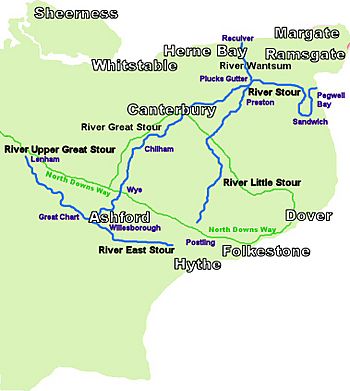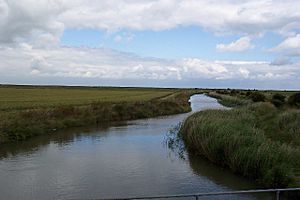River Wantsum facts for kids
Quick facts for kids River Wantsum |
|
|---|---|

River Stour and Tributaries
|
|
| Physical characteristics | |
| Main source | Reculver |
| River mouth | River Stour |
The River Wantsum is a small river in Kent, England. It flows into the River Stour. Long ago, the River Wantsum and the River Stour together formed a wide waterway called the Wantsum Channel. This channel separated the Isle of Thanet from the rest of Kent. Today, the River Wantsum is much smaller. It is mostly a drainage ditch. It starts near Reculver and ends where it meets the Stour.
Contents
The Wantsum Channel: A Historic Waterway
The Wantsum Channel was once a very important route. It allowed ships to sail between the mainland and the Isle of Thanet. This made Thanet an island.
How Wide Was the Channel?
In the 8th century, a historian named Bede wrote about the Wantsum Channel. He said it was about three furlongs wide. A furlong is about 200 meters, so that's about 600 meters wide! He also noted that you could only cross it in two places. Both ends of the channel flowed into the sea.
When Thanet Stopped Being an Island
Over many centuries, the Wantsum Channel slowly filled up. Sediment, like sand and mud, built up in the water. By 1414, people still used a ferry to cross the Wantsum at a place called Sarre. But by 1550, the channel had become so narrow that Thanet was no longer an island. You could walk across the former channel.
The Roman Fort at Reculver
The Romans built a fort at Reculver. This fort was important for defending the coast. When it was built, it was about 1.6 kilometers (1 mile) from the sea. However, the coastline changed over time. By the early 16th century, the fort was only about 400 meters (a quarter mile) from the sea. A big storm in 1809 even washed away half of the fort! Scientists believe that the material washed away by the sea helped to block the northern end of the Wantsum Channel.
The River Wantsum Today
Today, the River Wantsum is much smaller than it used to be. It is now a small tributary. It joins the Great Stour from the north. This happens just before the Little Stour joins from the south. After these two rivers meet, the combined river is simply called the River Stour.


